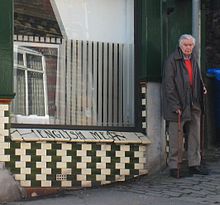カフェウォール錯視
カフェウォール錯視は、幾何学的錯視の1つ。白黒の「レンガ」を交互に並べた列の間の平行直線は傾いてみえるというものである。

初め1898年にキンダーガーテン錯視という名前で記述され[1]、1973年にリチャード・グレゴリーにより再発見された[2]。グレゴリーによると、この効果は彼の研究室のメンバーであるSteve Simpsonによりブリストルのセントマイケルズヒルの麓にあるカフェの壁のタイルで観察された。これは、ヒューゴー・ミュンスターバーグが生み出したずらしチェス盤錯視の別形である[3]。
錯視の構造において、各「レンガ」は、「レンガ」の濃い色と薄い色の中間色の「モルタル」の層に囲まれている[4]。
解体の最初の試みとして、錯視は主に発光によるものであり、光は網膜像において暗い部分から明るい部分へと広がり[5]、白黒が同じ明るさの異なる色に置き換えられると像が消える[6]。しかし、錯視の構成要素は全ての光学要素および網膜要素が括り出された場合も残る。コントラストの極性が傾斜方向を決定する要因となっているようである[7]。


関連項目
編集脚注
編集- ^ Pierce, A.H. (1898). “The illusions of the kindergarten patterns”. Psychological Review 5 (3): 233–53. doi:10.1037/h0070595.
- ^ Gregory, R.L.; Heard, P. (1979). “Border locking and the Café Wall illusion”. Perception 8 (4): 365–80. doi:10.1068/p080365. PMID 503767.
- ^ Münsterberg, H. (1897). “Die verschobene Schachbrettfigur”. Zeitschrift für Psychologie 15: 184–88.
- ^ Morgan, M.J.; Moulden, B. (1986). “The Münsterberg figure and twisted cords”. Vision Research 26: 1793–1800. doi:10.1016/0042-6989(86)90130-6.
- ^ Pierce, A.H. (1901). Studies in Auditory and Visual Space Perception. London: Longmans Green
- ^ Westheimer, G. (2007). “Irradiation, border location and the shifted-chessboard pattern”. Perception 36: 483–94. doi:10.1068/p5646.
- ^ Kitaoka, A; Pinna, B.; Brelstaff, G. (2004). “Contrast polarities determine the direction of Cafe Wall tilts”. Perception 33 (1): 11–20. doi:10.1068/p3346. PMID 15035325.
外部リンク
編集- An interactive web app for demonstrating the Café wall illusion
- An interactive version of the Café wall illusion that allows for adjusting the offset and turning the black boxes into white boxes
- An animated proof that the horizontal lines are parallel and straight
- The original café in Bristol on Google Maps Street View
- Sample architecture